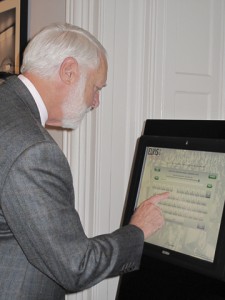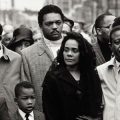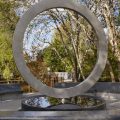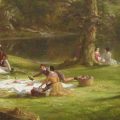From the Secretary: “Elvis at 21”—A mirror on America
In November I held a pair of two-month-old lion cubs and toured our new Smithsonian traveling exhibition at the National Portrait Gallery: “Elvis at 21: Photographs by Alfred Wertheimer,” on view through January 23, 2011. Both experiences underscored for me the poignancy of young life, so rich in possibility and potential growth.
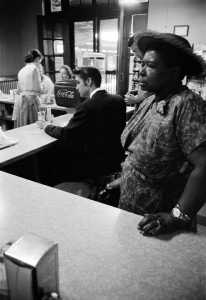
Segregated Lunch Counter. While waiting for a train to take him from Chattanooga to Memphis, a trip of some 400 miles, Elvis sits at the lunch counter to have some breakfast. The woman standing had ordered a sandwich for which she was waiting, but was not able to sit at the counter. Railroad station, Chattanooga, Tenn. July 4, 1956.© Alfred Wertheimer. All rights reserved.
The Elvis exhibition held a special resonance for me. Elvis and I both grew up in small southern towns and we both moved to Tennessee at the age of 13—he to Memphis, I to Chattanooga. Elvis’ earliest musical experiences were in Mississippi, home to the blues. In Memphis, he frequently attended all-night gospel singing at Ellis Auditorium. His family may have been poor, but the music enveloping him was rich indeed.
Blessed with perfect pitch, a mellifluous voice, and the ability to absorb any music he heard, Elvis began singing in clubs while still a teenager. In March 1956, RCA Victor hired photojournalist Alfred Wertheimer to shoot promotional photographs of its new but largely unknown artist. The 56 photographs in this exhibition that that will tour under the auspices of the Smithsonian Institution Traveling Exhibition Service capture the 21-year-old Elvis Presley during the pivotal year when he became a superstar.
The photographs show Elvis unnoticed, walking alone in New York City, sitting on a train, buying lunch at a local diner, rehearsing, and living back home in Memphis. There is a striking photograph of him playing the piano all by himself in the corner of a rehearsal space—a vulnerable young man, unaware of the fame and fortune that lay ahead that would change his life.
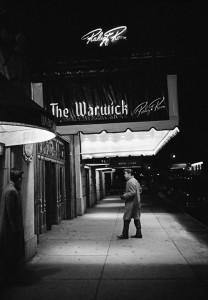
Entering The Warwick. Between the afternoon rehearsal and the evening performance of “Stage Show,” hosted by Tommy and Jimmy Dorsey, Elvis returns to his hotel to rest and freshen up. New York City. March, 17, 1956. © Alfred Wertheimer. All rights reserved.
Elvis was a natural performer, with enormous energy on stage. His television appearances— remembered still by millions—created an explosive celebrity. As exhibition curator Amy Henderson explains, “Each medium generates a different kind of celebrity: recordings and radio helped produce Bing Crosby’s and Frank Sinatra’s popularity; but it was black and white TV that broadcast Elvis Presley across our nation.”
Elvis was becoming famous when I was in high school. He appeared on shows hosted by Ed Sullivan, Milton Berle and Steve Allen. One of the most moving performances I saw of Elvis was a TV special devoted to gospel music, made early in his career. However, most of Elvis’ performances combined many different musical genres, including country, rhythm and blues, gospel, rock ‘n roll and jazz.
The SITES exhibition focuses on 1956, a pivotal time not only in Elvis’ career but also in our country’s history, when WWII was over but the Civil Rights movement had not quite emerged. People were beginning to understand that our country encompassed a large number of rich cultures and rich musical traditions, including those of African Americans. As the SITES exhibit opening label explains: “…1956 marked a turning point in America….in popular music, Elvis created an integrating synthesis of rhythm and blues, gospel, and country that bridged white and black, urban and rural…Elvis launched a cultural revolution, and Alfred Wertheimer captured its transit.”
The SITES show has a creative new electronic “green” guest book, which enables exhibition organizers to collect visitor comments and use the demographic information entered to draw conclusions about each generation’s view of Elvis. Neat!
The exhibit also provides a terrific example of SI collaboration. And because it is a SITES exhibition, it can reach the entire country, as SITES— the world’s largest traveling exhibition operation—has been doing for 57 years. For example, “Elvis at 21” will be on view at the William J. Clinton Presidential Library and Museum in Little Rock, Ark., next summer.
More than 400 communities nationwide host some 50 SITES exhibitions annually, many telling stories of American identity and accomplishment. As Leonard Bernstein once said of Elvis Presley, “He changed everything—music, language, clothes. It’s a whole new social revolution —the ‘60s came from it.” For the children of the ‘60s, and for their children today— indeed for all Americans—SITES holds up a mirror to America through this remarkable show.
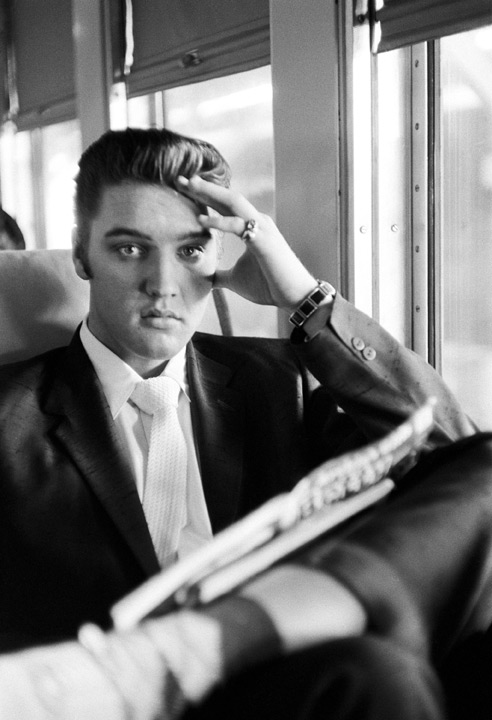
Going Home. Elvis on the Southern Railroad between Chattanooga and Memphis, Tenn. July 4, 1956. © Alfred Wertheimer. All rights reserved.
Posted: 1 December 2010
- Categories:
